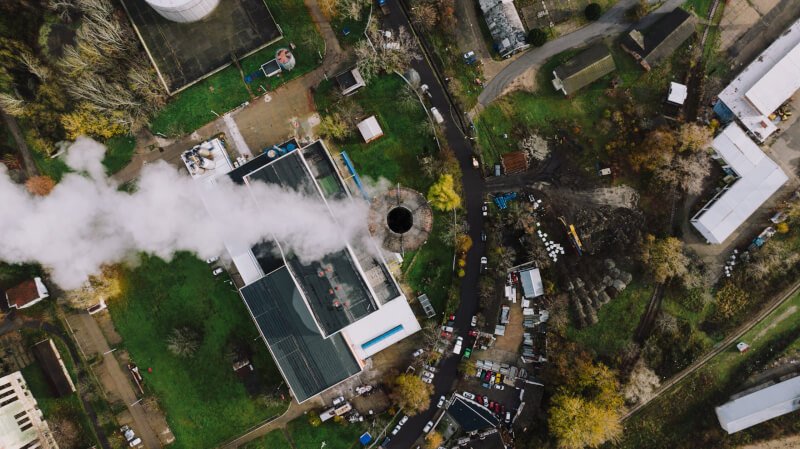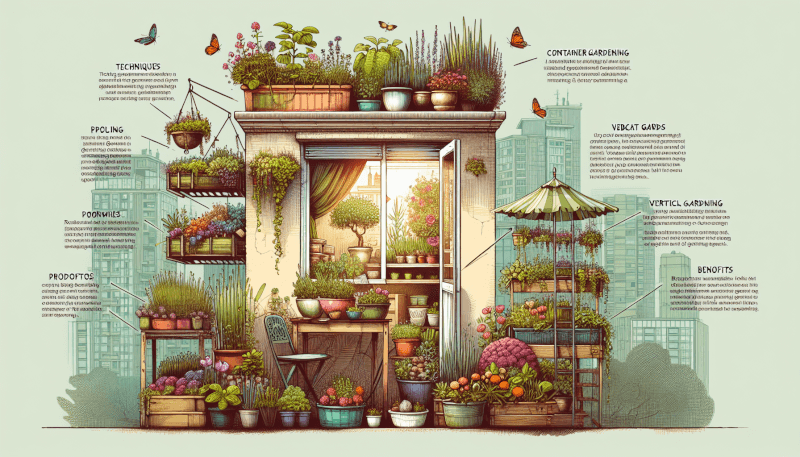Are you eager to bring the vibrant world of gardening to your small urban oasis? Look no further than the realm of small-space gardening, where the potential to cultivate a bountiful garden is within your grasp. From herbs and vegetables to captivating flowers and succulents, the possibilities for your urban garden are virtually endless. With a dash of creativity and a pinch of patience, you can transform even the tiniest of spaces into a lush and flourishing haven. So, roll up your sleeves, grab your gardening tools, and let’s explore the exciting world of maximizing your urban garden potential.

Choosing the Right Plants
Consider the Space and Lighting
When it comes to small-space gardening, it’s crucial to carefully consider the available space and lighting conditions. Assess how much space you have and whether it receives full sun, partial sun, or shade throughout the day. This will help you determine which plants are suitable for your garden. For instance, if you have a sunny balcony, you can opt for sun-loving plants like tomatoes, peppers, and herbs. On the other hand, if you have a shady corner, focus on shade-tolerant plants such as ferns, hostas, and impatiens.
Select Plants Suitable for Containers
Since space is limited, choosing plants that can thrive in containers is a smart move. Look for plants that have a shallow root system and don’t require a lot of space to spread out. Some popular container plants include lettuce, radishes, strawberries, and herbs like basil, mint, and parsley. Additionally, flowering plants like marigolds, petunias, and begonias can add a pop of color to your urban garden.
Choose Compact and Dwarf Varieties
Compact and dwarf varieties of plants are ideal for small gardens as they take up less space while still providing a bountiful harvest. These varieties are specifically bred to be more compact in size, making them perfect for small containers or raised beds. For example, you can choose compact tomato varieties such as “Tiny Tim” or “Patio Princess” for your urban garden. The same goes for other vegetables like cucumbers, peppers, and even melons.
Opt for Vertical Gardening Options
Vertical gardening is a fantastic way to maximize your small space. By utilizing walls, trellises, and hanging containers, you can grow plants vertically instead of horizontally. This technique not only saves space but also adds a visually appealing element to your garden. Consider installing wall-mounted planters to grow herbs or flowers, or use hanging baskets or tiered plant stands to grow a variety of vegetables and fruits. Vertical gardening is especially popular for those with balconies or limited ground space.
Preparing Your Small Space for Gardening
Assessing Soil Quality and Composition
Before starting your small-space garden, it’s essential to assess the quality and composition of your soil. Take a close look at the soil’s texture, structure, and drainage capabilities. Sandy soils drain quickly but may require more frequent watering, while clay soils retain moisture but can become compacted. If your soil seems lacking, consider getting a soil test done to determine its nutrient levels and pH balance.
Amending the Soil for Better Drainage
In small gardens, it’s crucial to ensure proper drainage to prevent waterlogged roots and potential root rot. If your soil doesn’t provide adequate drainage, you can improve it by adding organic matter such as compost, well-rotted manure, or peat moss. These amendments help loosen the soil, enhance its ability to retain moisture, and promote healthy root growth.
Determining the Best Planting Techniques
When it comes to small-space gardening, determining the best planting techniques is crucial for maximizing space and ensuring successful growth. Consider using techniques like square-foot gardening, which involves dividing your planting area into grids. This method allows you to grow a variety of plants in a limited space while ensuring efficient use of resources. Additionally, interplanting compatible plants and using succession planting can help you make the most of your small garden.
Creating Raised Beds or Container Gardens
Raised beds and container gardens are excellent options for small-space gardening. They not only help define your garden area but also provide better control over soil quality, drainage, and weed management. Raised beds can be constructed using wood, brick, or even recycled materials, while container gardens allow you to grow plants in various containers such as pots, buckets, or even recycled items like old tires. These options give you the flexibility to elevate your gardening experience in a small urban setting.

Essential Tools and Supplies
Gardening Gloves and Hand Tools
Having the right tools and supplies is essential for any garden, regardless of size. Invest in a pair of high-quality gardening gloves to protect your hands while working in the garden. Additionally, some essential hand tools like a trowel, hand pruners, and a hand fork will come in handy for planting, pruning, and maintaining your small-space garden.
Small-Scale Irrigation Systems
Watering your plants efficiently is crucial in a small-space garden. Consider installing a small-scale irrigation system like a drip irrigation setup. Drip irrigation delivers water directly to the plant’s root zone, minimizing water wastage through evaporation and runoff. This system can be easily set up with a timer, ensuring your plants receive the right amount of water at the right time, even if you’re busy or away from home.
Quality Potting Mix and Fertilizers
Since your plants will be growing in containers or raised beds, it’s important to use a high-quality potting mix. Potting mixes are specifically formulated to provide adequate drainage, aeration, and nutrients for container plants. Look for mixes that contain a good blend of organic matter, perlite, and vermiculite. Additionally, consider using organic fertilizers to nourish your plants without the risk of chemical buildup in a small garden space.
Support Structures for Vertical Gardening
If you’re planning to incorporate vertical gardening techniques, having appropriate support structures is crucial. For wall-mounted planters, ensure that the brackets or racks are sturdy enough to hold the weight of the containers and plants. If you’re using trellises or arbors, make sure they are firmly anchored to the ground or wall to support climbing plants. Utilize hooks or brackets for hanging baskets or tiered plant stands to prevent accidents and ensure the proper display of your plants.
Utilizing Vertical Gardening Techniques
Installing Wall-Mounted Planters
Wall-mounted planters are a fantastic way to add greenery to your small-space garden without taking up valuable floor space. These planters can be easily attached to walls or fences, creating an eye-catching vertical display. Consider using them to grow herbs, flowers, or even small vegetables like lettuce or strawberries. Ensure that the planters are securely fastened to avoid any accidents or damage to your plants.
Building Trellises and Arbors
Trellises and arbors are excellent support structures for climbing plants and vines. They not only provide vertical growing space but also create a visually appealing focal point in your garden. Use trellises and arbors to grow vegetables like beans, peas, and cucumbers, or flowering vines like morning glories or sweet peas. Be sure to place these structures in areas that receive adequate sunlight and provide enough space for the plants to climb and spread.
Using Hanging Baskets or Tiered Plant Stands
Hanging baskets and tiered plant stands are perfect for adding a touch of beauty and lushness to your small-space garden. Hang baskets from sturdy hooks or brackets to create cascades of flowers or trailing plants. Tiered plant stands allow you to display multiple plants at different heights, maximizing the use of vertical space. Consider using these options for growing herbs, succulents, or a mix of colorful annuals to brighten up your garden.
Growing Plants on Balconies and Window Sills
If you have a balcony or a window sill, you have excellent opportunities for small-space gardening. Utilize railing-mounted planters or window boxes to grow flowers, herbs, or small vegetables. Balcony gardens can also benefit from vertical trellises or hanging pots to maximize space. Take advantage of these vertical gardening techniques to create a green oasis in your urban dwelling.

Maximizing Sunlight Exposure
Identifying Sunniest Spaces in Your Garden
In urban environments, sunlight can be limited due to tall buildings or surrounding structures. Therefore, it’s essential to identify the sunniest spaces in your garden to make the most of the available light. Observe your garden throughout the day to determine areas that receive the most sunlight. These areas are ideal for sun-loving plants, vegetables, and fruits that require full sun exposure to thrive.
Pruning Overhanging Branches or Obstructions
One challenge in small-space gardening is dealing with overhanging branches or structures that cast shade on your garden. Regularly prune any overhanging branches or trim back strategically placed plants to allow maximum sunlight into your garden. Additionally, consider removing or rearranging any obstructions that block the sunlight, such as trellises or garden furniture, to create a more sun-friendly environment for your plants.
Using Reflective Surfaces to Boost Sunlight
Another way to maximize sunlight in your small-space garden is to use reflective surfaces strategically. Consider placing light-colored or glossy objects near your plants to reflect and redirect sunlight onto them. This can include using mirrors, aluminum foil, or white pebbles around your garden. Reflective surfaces can help increase the amount of sunlight reaching your plants, especially in areas with limited direct sunlight.
Utilizing Shade-Tolerant Plants in Shaded Areas
While maximizing sunlight exposure is important, it’s also crucial to utilize shaded areas in your garden effectively. Instead of viewing areas with shade as a limitation, embrace them as opportunities to grow shade-tolerant plants. Shade-loving plants like ferns, hostas, and impatiens thrive in areas with partial or dappled shade. By carefully selecting the right plants for shaded areas, you can create a well-balanced and visually appealing small-space garden.
Watering Techniques for Small-Space Gardens
Drip Irrigation Systems for Efficient Watering
Watering a small-space garden can be challenging, especially when it comes to ensuring each plant receives the right amount of water. Installing a drip irrigation system can help eliminate this challenge. Drip irrigation delivers water directly to the plant’s root zone, minimizing water loss due to evaporation and ensuring efficient water usage. With a drip system, you can easily set timers, allowing your garden to be watered automatically at the optimal times each day.
Using Self-Watering Containers
Self-watering containers are an excellent option for small-space gardens, especially for busy gardeners who may not have the time to water their plants daily. These containers have built-in reservoirs that hold water, supplying it to the plants as needed. Self-watering containers provide a consistent moisture level for your plants, minimizing the risk of over or under-watering. They are particularly useful for growing vegetables, herbs, and flowers that prefer consistently moist soil.
Mulching to Retain Moisture
Mulching is a simple and effective technique to retain moisture in your small-space garden. Apply a layer of organic mulch, such as straw, wood chips, or shredded leaves, around your plants. Mulch helps to conserve moisture by reducing evaporation, regulating soil temperatures, and suppressing weed growth. This technique is particularly beneficial during hot summer months when water can quickly evaporate from the soil.
Monitoring Soil Moisture Levels
Regularly monitoring soil moisture levels is crucial in small-space gardens to ensure your plants are receiving adequate water. Use your fingers or a moisture meter to check the moisture content of the soil. Water your plants when the top inch of soil feels dry. Be cautious not to overwater, as this can lead to root rot and other plant problems. By monitoring soil moisture levels, you can ensure your plants remain healthy and hydrated throughout the growing season.

Companion Planting in Small Spaces
Choosing Complementary Plant Combinations
Companion planting is a technique that involves planting different species together for mutual benefits. In small-space gardens, companion planting can help maximize limited space and improve overall plant health. Choose plant combinations that complement each other, such as tall plants that provide shade for shorter, heat-sensitive crops. For example, you can plant corn, beans, and squash together using the “Three Sisters” technique. The corn provides support, the beans fix nitrogen in the soil, and the squash acts as a living mulch, suppressing weeds.
Utilizing Beneficial Insect-Repelling Plants
In small gardens, it’s crucial to manage pests without relying heavily on pesticides. Utilize beneficial insect-repelling plants to naturally deter pests and promote a healthy garden ecosystem. For example, planting marigolds helps deter nematodes, while companion planting with herbs like basil, rosemary, and thyme can repel pests like aphids, whiteflies, and mosquitoes. By incorporating these plants, you not only enhance your garden’s visual appeal but also reduce the need for chemical pest control.
Implementing the Three Sisters Technique
The Three Sisters technique is an ancient Native American method of companion planting that maximizes space and promotes healthy plant growth. This technique involves planting corn, beans, and squash together, utilizing the plants’ natural symbiotic relationships. The corn provides support for the beans to climb, while the beans fix nitrogen in the soil, benefiting the corn and squash. The squash acts as a living mulch, suppressing weeds and conserving soil moisture. Implementing the Three Sisters technique is a fantastic way to optimize your small-space garden and create a sustainable ecosystem.
Creating Microclimate within Your Garden
In small gardens, creating microclimates can help maximize the growing potential of different plant species. Microclimates refer to localized climate conditions that differ from the surrounding area. For instance, placing a raised bed near a south-facing wall can create a warmer microclimate, allowing you to grow heat-loving plants that may not thrive in cooler areas of your garden. Creating microclimates involves strategic placement of plants to take advantage of temperature variations, wind patterns, and shade exposure.
Creative Container Gardening Ideas
Repurposing Everyday Objects as Planters
Container gardening offers endless possibilities for creativity, especially in small spaces. Think outside the box by repurposing everyday objects as planters. Turn old tin cans into herb pots, use an old wheelbarrow as a mobile vegetable garden, or convert a wooden crate into a rustic flower box. Get creative with items such as teapots, rain boots, or even a vintage suitcase. These unique containers not only add personality to your garden but also serve as conversation starters.
Arranging Plants in Hanging Shoe Organizers
Hanging shoe organizers can be a fantastic vertical gardening solution for small spaces. Attach them to fences, walls, or balconies and fill each pocket with soil and plants. This method allows you to grow a variety of herbs, flowers, or small vegetables in a compact and organized way. Hanging shoe organizers are readily available and offer an inexpensive and innovative way to maximize your small-space garden’s potential.
Using Vertical Pallet Gardens
Pallets offer an excellent opportunity for vertical gardening. Transform a wooden pallet into a vertical garden by attaching landscape fabric to the back and sides and filling it with potting soil. Then, simply plant your desired plants in the spaces between the slats. Pallet gardens are ideal for growing herbs, lettuces, and trailing flowers. They can be leaned against a wall or fence or even mounted vertically to create a living green wall.
Creating Mini Herb Gardens in Window Boxes
Window boxes are perfect for small-space gardens, especially for growing herbs. Place a few window boxes with a sunny exposure, like your windowsill or balcony railing, and fill them with your favorite herbs. This allows easy access to fresh herbs for cooking or garnishing. Choose compact herb varieties like thyme, basil, or rosemary, and enjoy the convenience of having a mini herb garden right outside your window.
Managing Pests and Diseases in Small Gardens
Identifying Common Urban Garden Pests
Small gardens are not immune to pests, and it’s essential to be able to identify and manage them effectively. Common urban garden pests include aphids, whiteflies, slugs, snails, and caterpillars. Regularly inspect your plants for signs of pests such as chewed leaves, sticky residue, or discolored foliage. Early detection and intervention are key to preventing pests from spreading and causing significant damage to your small-space garden.
Implementing Organic Pest Control Methods
In a small-space garden, it’s best to avoid or minimize the use of chemical pesticides. Instead, opt for organic pest control methods that are safe for you, your plants, and the environment. These methods include using beneficial insects like ladybugs and lacewings to prey on pests, introducing companion plants that repel insects, and physical barriers like netting or row covers to protect your plants. Regularly inspect your plants and intervene at the first sign of pests to nip the problem in the bud.
Recognizing and Treating Plant Diseases
Plant diseases can quickly spread and wreak havoc in a small-space garden if not promptly addressed. Familiarize yourself with common plant diseases such as powdery mildew, fungal infections, and bacterial blights. Look for signs like yellowing leaves, black spots, wilting, or stunted growth. If you suspect a plant is diseased, promptly remove and dispose of infected plant parts. Consider using organic disease control methods like neem oil or copper-based fungicides to combat plant diseases effectively.
Promoting Garden Biodiversity for Pest Management
Promoting garden biodiversity is a smart strategy for managing pests in small gardens. By encouraging a diverse range of plants and beneficial insects, you can create a natural balance that helps control pest populations. Grow a variety of plants with different colors, shapes, and heights to attract a wide range of beneficial insects like ladybugs, lacewings, and hoverflies. Additionally, provide habitats like birdhouses, insect hotels, or small ponds to attract beneficial predators that feed on pests.
Harvesting and Preserving Your Urban Garden
Knowing the Right Time to Harvest Vegetables
Knowing when to harvest your vegetables is crucial for optimal taste and quality. Each vegetable has specific signs to look for when determining its readiness for harvest. For example, with tomatoes, the fruit should be fully colored and slightly soft to the touch. Leafy greens like lettuce are best harvested when the leaves are young and tender. Regularly monitor your vegetable plants and harvest them at their peak to enjoy the freshest and most flavorful produce.
Properly Storing and Preserving Fresh Produce
Properly storing and preserving your harvested produce ensures you can enjoy the fruits of your labor beyond the growing season. Some vegetables, like root crops, can be stored in a cool, dark place with good ventilation. Others, like tomatoes or peppers, are best stored at room temperature. Leafy greens and herbs can be kept fresh by placing them in a container with a damp paper towel in the refrigerator. Preserve surplus produce by canning, freezing, or dehydrating them for future use.
Drying Herbs and Making Herbal Infusions
Herbs are a wonderful addition to any small-space garden, and drying them allows you to enjoy their flavors and aromas long after the growing season ends. Harvest herbs when their essential oils are at their peak, usually in the morning before the heat of the day. Bundle them with twine and hang them in a warm, well-ventilated area to dry. Once dry, store them in airtight containers away from direct sunlight. You can also use dried herbs to make herbal infusions for teas or culinary purposes.
Freezing or Canning Fruits and Vegetables
Freezing or canning is an excellent way to preserve the abundance of fruits and vegetables from your small-space garden. Some fruits and vegetables can be blanched and frozen, while others are better suited for canning. Blanching involves briefly scalding the produce in boiling water, then rapidly cooling it in ice water, before packaging for freezing. Canning, on the other hand, involves heating the produce in jars with added preserving agents like sugar or vinegar and sealing them to create a shelf-stable product. Explore different freezing and canning techniques to preserve the flavors of your urban garden.


